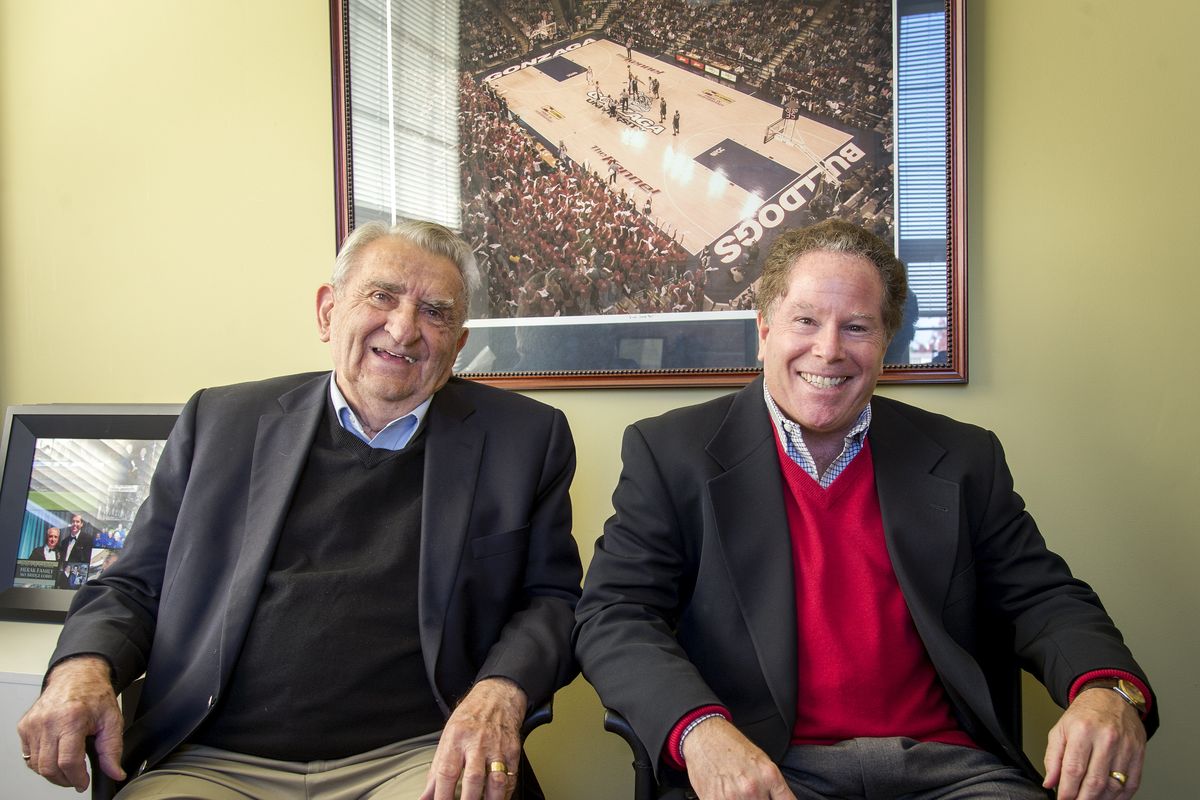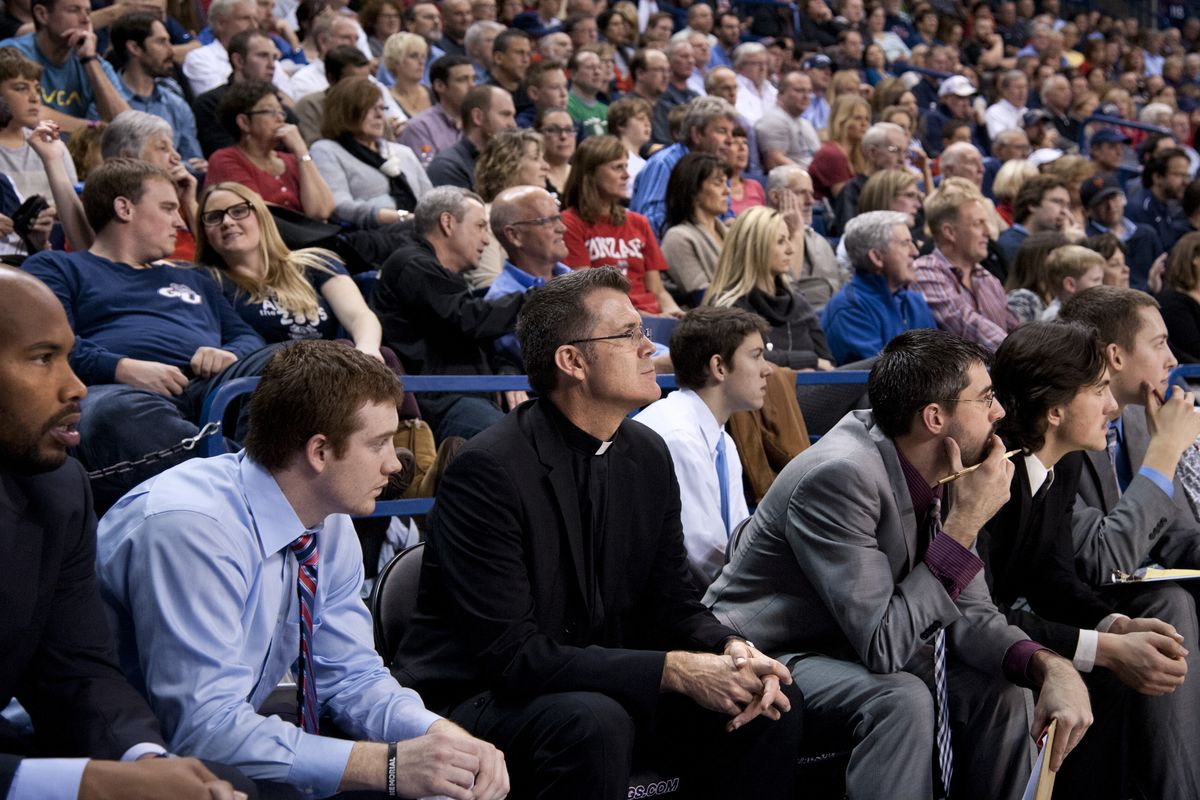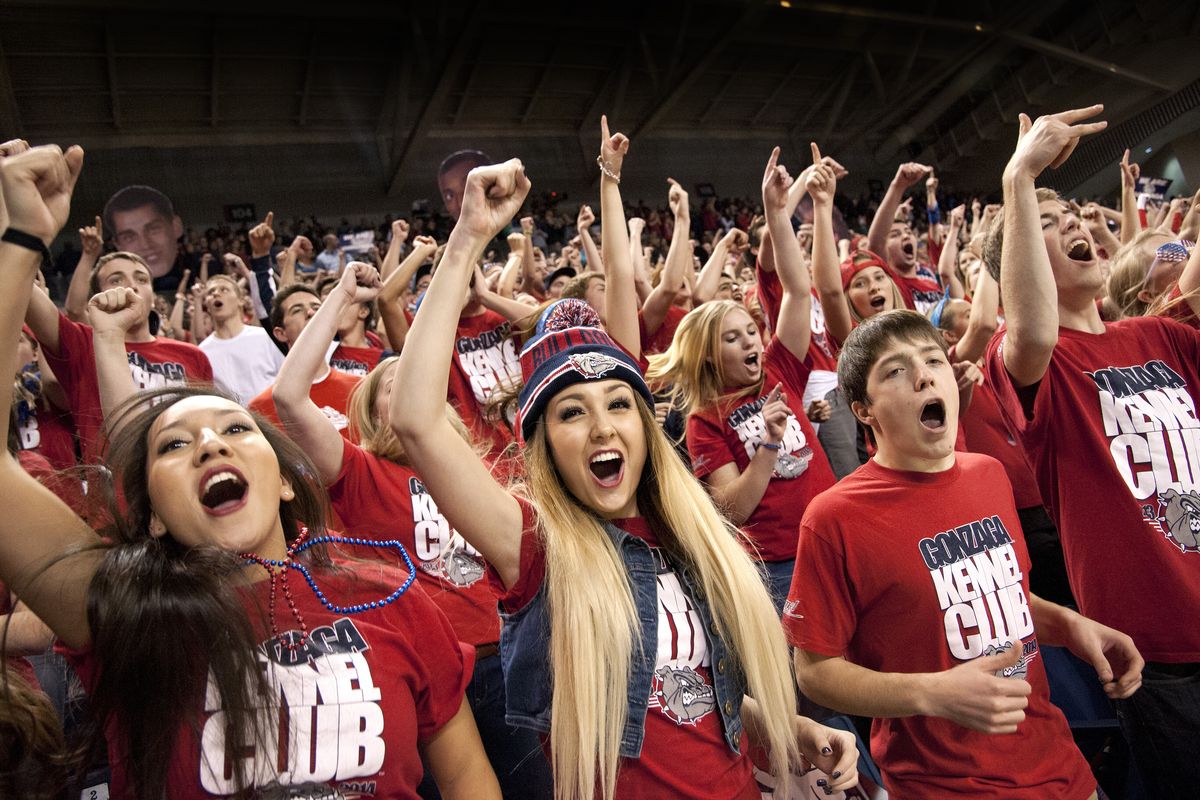Gonzaga University’s basketball success fuels unprecedented growth
Gonzaga University’s Kennel Club turns up the volume during a men’s basketball game against Oakland in McCarthey Athletic Center on Nov. 17. (Dan Pelle)Buy a print of this photo
Gonzaga University’s basketball team has netted more than just wins in the past 15 years.
The Zags have spawned a transformation of a tiny, struggling college into a national brand and a money magnet.
The Jesuit liberal arts college enrolled 7,605 students this fall, 82 percent more than the 4,185 who attended classes in 1999.
Donors have swollen the college’s coffers to $173.3 million, nearly doubling its endowment. The university’s budget has almost tripled.
And generous pledges have enabled Gonzaga to build a $25 million basketball arena, a baseball complex, student apartments, an applied science building and other projects. A $60 million student center is under construction.
“Gonzaga was really suffering (in 1999),” said Don Herak, a trustee emeritus and major donor. “The basketball team was the catalyst for changing Gonzaga.”
As the basketball season tips off, the team is ranked No. 13. The Zags’ streak of 15 consecutive appearances in the NCAA Tournament is among the nation’s best, trailing only perennial powers Kansas, Duke and Michigan State. The 1999 squad went furthest: a trip to the Elite Eight. The team hasn’t been back to the brink of the Final Four since then.
Yet the team has achieved many other triumphs. Among them are five trips to the Sweet Sixteen, a No. 1 overall ranking in the final regular season poll of the 2012-13 season and more than two dozen players who became professionals.
“Basketball – that’s how I heard about Gonzaga. I visited and got a good vibe,” said Gene Dawydiak, a Gonzaga senior and San Francisco native. Once enrolled, however, “I was disappointed it wasn’t as Catholic as I thought it would be; 99.9 percent of the time I forget it’s a Catholic school until I see a crucifix.”
Outside the fame and financial gain fostered by the Zags’ on-court success, the face of the university is changing.
• The number of minority undergraduates at Gonzaga has doubled to 1 in 5 students in the past 10 years.
• About 17 percent of undergraduate students received Pell Grants this school year, up 5 percentage points from seven years ago.
• Students who are the first in their family to attend college now make up 18.4 percent of the freshman class.
• About 95 percent of students receive some sort of financial aid.
• The school is led by its first non-Jesuit president, Thayne McCulloh.
Gonzaga’s student population has grown so fast the college has to secure rooms at a nearby hotel for housing. More than 3,000 students live on or near the 131-acre campus in 16 residence halls, eight apartment complexes and numerous houses in the Logan neighborhood.
The college offers 75 undergraduate programs at $34,570 in tuition and fees a year. Room and board are extra. There are 25 graduate programs, a law school and more.
And yet for all of that, there aren’t enough seats for all of the students wanting to go to home basketball games. Gonzaga has 1,250 free seats set aside for students on a first-come-first-served basis.
The university is a force in the community, too.
The school, students and visitors put tens of millions of dollars into Spokane’s economy each year. Students volunteer in public schools, help provide meals to the needy and give free legal help on certain cases.
“It’s a major influence on Spokane, Washington,” Herak said. “They make a difference.”
Some of Gonzaga’s most generous benefactors are evident on a stroll through its ever-expanding campus.
There’s the (Jim and Joanne) Jundt Art Center; the (Mert and Jessie) Rosauer School of Education; the (Bing) Crosby Center; and the (Phil and Tom) McCarthey Athletic Center. In autumn 2015, there also will be the (John J.) Hemmingson University Center. Those buildings and others reflect the donated millions of dollars rooted in the Jesuit university’s traditions and its motto: Educating the people the world needs the most.
“Gonzaga has given the McCarthey family far more than they have given it,” said Phil McCarthey, an alumnus and member of the board of trustees. McCarthey, his brother, Tom, and several of the family’s children have graduated from Gonzaga.
So when former President Rev. Robert Spitzer needed someone to make the primary donation for a new basketball arena, he invited the McCarthey brothers to lunch. Make that three lunches.
“We saw a bit of a sleeping giant,” said Phil McCarthey, who graduated from Gonzaga with Spitzer. “We saw a bit of an opportunity. We had the vision, not that the basketball team could be No. 1, but that it could be better.”
Herak’s connection with the university began at an early age.
“Gonzaga really changed my life,” said Herak, a 1946 graduate in civil engineering. “I met the people who made the difference in my life, so I owe Gonzaga so much for the success I’ve had.”
An engineering school building bearing Herak’s name is just one sign of his support. He also has given substantial money to the university’s athletic programs and scholarship funds.
Gonzaga alumni think giving is an obligation because they’ve been fortunate.
“If you have the ability to give and you don’t give, you aren’t being fair to your community,” said Herak, also a major supporter of the Spokane Symphony and local Catholic schools.
There are so many stories about “people who believed in what Gonzaga could be and do,” said McCulloh, the university’s president. “As we researched our 125th anniversary and the anniversary of our law school, what you become so acutely aware of is how dependent we are on our alums. It’s humbling.”
Harry and Colleen Magnuson saved the college from closing in the 1970s by putting their own credit on the line to secure Gonzaga’s debt. Mert and Jessie Rosauer, devout Catholics who did not graduate from Gonzaga, helped fund the education center and dozens of annual scholarships.
Benefactors donated about $16 million during the 2012-13 school year. That doesn’t include the largest single gift in the school’s history: a $25 million donation from John Hemmingson to help build the new student center.
“It’s not conceivable that we could build a $60 million student center without a sizeable donation,” McCulloh said. “And that attracts other people because they are sure it’s going to happen.”
Gonzaga is not a state-funded college. The school receives some federal dollars and state money through its students via monetary awards.
“The largest degree of funding depends on the families saying it’s worth doing,” McCulloh said. “As occasionally happens, especially in this economy, there are a number of private colleges that fold every year. To make a private college work, it requires a requisite amount of people to want to come here in the first place, and a requisite number of people to want to work here, all coming together in a way that is affordable and sustainable.”
A whole arm of the university – 45 employees – is involved in fundraising. The largest group is the development team.
“They do everything from finding out who is out there to working directly with benefactors to find out where their interests mesh with the university,” McCulloh said. “Another group works with our alumni nationally, and to some extent internationally. Our alumni are critical.”
Many people who invest in the college also play a role in making decisions.
“That’s the nature of the beast,” Herak said.
Many of Gonzaga’s 31-member board of trustees have made major donations to the university. Some are alumni. One-third of the members are Jesuits.
The board of regents, a 60-plus member group that advises the trustees, is another long list of benefactors.
“It’s all about people,” McCulloh said. “It all comes down to people.”


